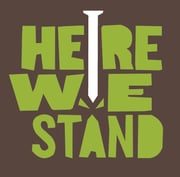A Guide to Using Here We Stand Remotely
Whether you are new to Here We Stand or have been a long-time subscriber, you know that Here We Stand offers dozens of lessons that help you design confirmation ministry that fits your context. Whether you’re using the 2-year plan, the 3-year plan, or a scope and sequence you’ve designed yourself, these lessons can be adapted to fit remote confirmation ministry this fall
- First, decide the topics you want to cover this fall and choose the corresponding lessons.
- Second, plan to distribute a Here We Stand Student Book and Here We Stand Lutheran Study Bible to each youth in your confirmation program. (You’ll find the Small Catechism in both of these resources.)
- Third, explore the lesson format to see what parts to keep as-is, what parts to adapt, and what parts to skip. The guidelines below will help you plan remote confirmation.
Each lesson’s Leader Guide provides Deep Prep, Quick Prep, Adolescent Connection, and Baptismal Connection sections to help you prepare. As you reflect on the Adolescent Connection, think through how the pandemic has added challenges, insights, and considerations to the topic.
During your time to Gather, spend more time checking in with students and less time reviewing past content. Students want to know you are there to support them and tune into their needs. Choose the Getting Started option that works best for remote learning. (Some skits may work better than others.) For the Opening Prayer, ask one or more students to lead the group in prayer. For all activities, the PowerPoint presentation can be a visual guide for the content.
Every Teach section provides many prompts for conversation, reflection, and response during My Faith Story, Open the Bible, and Open the Catechism. Here’s where you’ll need to consider which content is most relevant to your students and most doable for remote learning. Every Here We Stand lessons provides a lot of content in each of these sections. Rather than blazing through all the discussion points and questions, you may find that dwelling on a few points leads to more thoughtful, deep conversation. Search for ways to include photos, visual aids, interesting objects and artifacts, and other elements that ensure this time features dialogue rather than presentation. Wrap up this section with the Quiz Show using the PowerPoint slides. (You can always add your own slides!)
After the Teach time, Here We Stand encourages you to Take a Break. How could you do this remotely? Eat a snack, ask a few trivia questions, show pictures of the cute babies at your church, see how many quarters youth can flip off their elbows . . . you’ve got options.
Now it’s Connect time. If you have enough students to form small groups, plan for them to go to breakout rooms with their leaders. If not, stay together and explore one of the Group Connection options that you adapt, or just move to the Bible Connection using the Student Sheets, where you can also talk about the cartoon. You can also choose activities from the Student Book and Life Connection sections. While some of these activities for small group time cannot be adapted for remote learning, many ideas can move into the virtual space as-is or with only minor changes.
When you are ready to Send, choose the best Wrap Up question to ask, then move to the Closing Prayer, inviting students to join in. After you share the Blessing, you can invite them to make the sign of the cross with a family member.
Like all remote ministries that leaders like you have been planning since the pandemic began in March, it may take some sessions to find your groove with kids. With Here We Stand, you’ve got lots of options and possibilities.
Learn more about the guidelines for using Sparkhouse resources, including video, remotely by checking out our frequently asked questions.
Find the resources you need for Re:form at wearesparkhouse.org/herewestand.

